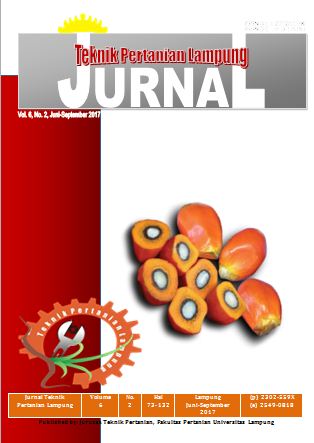KARAKTERISTIK PENGOLAHAN LIMBAH CAIR PABRIK MINYAK KELAPA SAWIT DALAM BIOREAKTOR CIGAR SEMI KONTINU
Abstract
Palm oil mill effluent (POME) waste water contains high consentration of organic pollutants. Anaerobic treatment is suitable to reduce the pollutans and also produce methane as one of renewable energy sources. Anaerobic degradation is complicated and sensitive process to the environtment, such as temperature and organic consentration. This study aims to determine characteristic of palm oil mill waste water treatment using semicontinue anaerobic CIGAR bioreactor. The seed was collected from sludge of anaerobic pond at POME treatment facility of PTPN VII Bekri. The substrat used in this experiment was fresh POME from the same mill. Initially, 4,375m3 of sludge was introduced into the bioreactor. The seed was acclimatized at a loading rate of 50 l/day for about a week. Anaerobic treatment was conducted at room temperature and the substrat was fed semicontinuelly at a loading rate of 100 to 350 liter/day. Results showed, that the stability of anaerobic degradation was achieved at an organic loading rate (OLR) of 0,9-3,11 kg/m3/day with COD removal more than 90% and maximum biogas production of 2,59 m3/day.
Keywords : palm oil mill effluent, anaerobic bioreactor, COD removal, biogas.
References
Abdurahman N.H. and N.H. Azhari. 2013. Effect of Organic Loading Rate on The Performance of UAMAS in Treating POME. Journal of American Science, 9: 23-31.
Bala, J.D., J. Lalung, and N. Ismail. 2014. Palm Oil Mill Effluent (POME) Treatment ‘‘Microbial Communities in an Anaerobic Digester’’: A Review. International Journal of Scientific and Research Publications, 4(6): 1-24
Bala, J.D., J. Lalung, and N. Ismail. 2015. Studies on the reduction of organic load from palm oil mill effluent (POME) by bacterial strains. International Journal of Recycling of Organic Waste in Agriculture, 4:1–10.
Choorit, W. and P. Wisarnwan. 2007. Effect of temperature on the anaerobic digestion of palm oil mill effluent. Electronic Journal of Biotechnology, 10(3): 376-385.
Hasanudin U. 1993. Pengolahan Limbah Cair Minyak Kelapa Sawit dengan Bioreaktor Unggun Fluidisasi Anaerobik Dua Tahap. Tesis Master. Program Studi Teknik Kimia, ITB, Bandung.
Hasanudin, U, R. Sugiharto, A. Haryanto, T. Setiadi, and K. Fujie. 2015. Palm oil mill effluent treatment and utilization to ensure the sustainability of palm oil industries. Water Science and Technolology, 72(7):1089-95.
Ibrahim, A.H., I. Dahlan, M.N. Adlan, and A.F. Dasti. 2012. Comparative study on characterization of Malaysian palm oil mill effluent. Research Journal of Chemical Sciences, 2(12): 1-5.
Labatut R.A. dan C A Gooch, Monitoring of Anaerobic Digestion Process to Optimize Performance and Prevent System Failure, Cornel University, diunduh September 2016,
Naibaho P.M. 1998. Teknologi Pengolahan Kelapa Sawit. Pusat Penelitian Kelapa Sawit, Medan. 306 halaman.
Nwabanne, J.T., A.C. Okoye, and H.C. Ezedinma. 2012. Kinetics of Anaerobic Digestion of palm oil mill effluent. Canadian Journal of Pure and Applied Science, 6(1): 1877-1881.
Poh, P.E. and M.F Chong. 2009. Development of anaerobic digestion methods for pal moil mill effluent (POME) treatment. Bioresources Technology, 100: 1–9.
Sarono. 2014. Strategi Pengurangan Gas Rumah Kaca Melalui Konversi Limbah cair Pabrik Kelapa Sawit Menjadi Energi Listrik, Desertasi Doktor. Program Studi Teknologi Industri Pertanian, IPB, Bogor.
Simanjuntak, H. 2009. Studi korelasi antara BOD dengan unsur hara N, P, dan K dari limbah cair pabrik kelapa sawit (PKS). Tesis Master. Sekolah Pascasarjana, Universitas Sumatera Utara, Medan.
Tchobanoglous G, F.L. Burton, and H.D. Stensel. 2003, Waste Water Engineering Treatment and Reuse, Mc Graw Hill, Fourth Edition, 1819 halaman.
Vijaya S, A.N. Ma, dan Y.M, Choo. 2010. Capturing Biogas : A Means to Reduce Green House Gas Emissions for the Production of Crude Palm Oil, American Journal of Geosciensce, 1: 1-6.
Yejian, Z., Y. Li, C. Lina, L Xiuhua, M. Zhijian, and Z. Zhenjia. 2008. Start-up and operation of anaerobic EGSB reactor treating palm oil mill effluent. Journal of Environmental Sciences, 20: 658-663.
Zinatizadeh, A.A.L., A.R. Mohamed, M.D. Mashitah, A.Z. Abdullah, and M. H. Isa. 2007. Optimization of pre-treated palm oil mill effluent digestion in an up-flow anaerobic sludge fixed film bioreactor: A comparative study. Biochemical Engineering Journal, 35: 226–237.
Downloads
Published
Issue
Section
License
- Authors who publish with this journal agree to the following terms:
- Authors retain copyright and grant the journal right of first publication with the work simultaneously licensed under a Creative Commons Attribution-ShareAlike 4.0 International Lice that allows others to share the work with an acknowledgement of the work's authorship and initial publication in this journal.
- Authors are able to enter into separate, additional contractual arrangements for the non-exclusive distribution of the journal's published version of the work (e.g., post it to an institutional repository or publish it in a book), with an acknowledgement of its initial publication in this journal.
- Authors are permitted and encouraged to post their work online (e.g., in institutional repositories or on their website) prior to and during the submission process, as it can lead to productive exchanges, as well as earlier and greater citation of published work (See The Effect of Open Access).
Jurnal Teknik Pertanian Lampung

JTEPL is licensed under a Creative Commons Attribution-ShareAlike 4.0 International License.

